‘Extraordinary’: Mystery of the ancient Nebra Sky Disc explored
Two metal detectorists scoured a German forest looking for treasure – and found it. But there was only one problem.
It’s 3800 years old. It holds the oldest known depiction of the night sky. And its meaning is lost to time.
Since its discovery, the Nebra Sky Disc has been embroiled in controversy.
Is it a forgery?
Is it an advanced calendar?
Or a symbolic adornment?
Its potential as one of the most significant historical finds ever has made the 31cm bronze disc the subject of intense study.
Much about it was mysterious.
Where did it come from?
What does the odd arrangement of the sun, moon and stars mean?
How did ancient metalsmiths make it so durable while also mere millimetres thick?
Some experts, however, have argued the Nebra Sky Disc was too good to be true.
It was looted by treasure hunters. It was recovered from the black market. It was in unusually good condition.
Now, two decades after being seized by police, the precious object is giving up its secrets.
“The Nebra Sky Disc is an extraordinary relict of the Early Bronze Age and an impressive example of the profound knowledge that was available in the Únětice culture,” German researchers conclude in a new study published in the science journal Nature.
“The latest research results make it clear that the early Bronze Age craftsmen were not only outstanding casters, but also mastered complex bronze processing techniques, for example hot forging, at the highest level.”
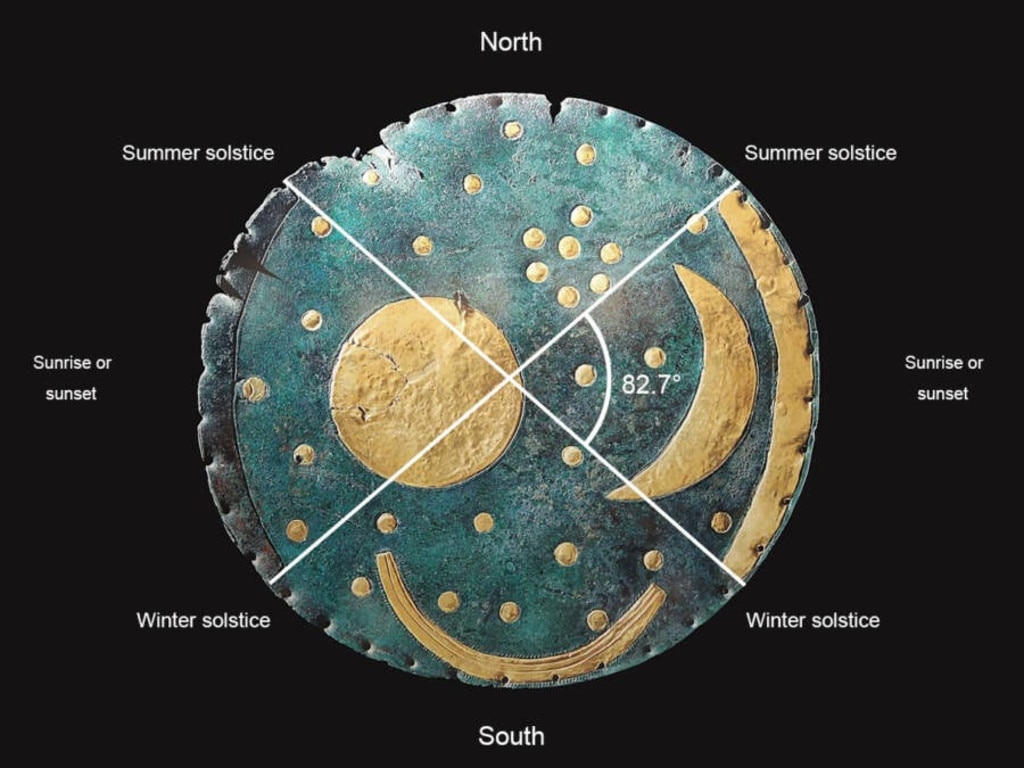
From loot to enlightenment
Two metal detectorists were scouring a German forest for treasure in 1999.
They found it.
Their handheld sensors picked up a signal on Mittelberg Hill near the town of Nebra.
Digging into the dark soil, they quickly uncovered two exquisite bronze swords, two axes, a chisel and spiral armbands.
And among this bronze-age booty was the glitter of gold.
It came from an odd blue-green disc. The precious metal was inlaid in the shape of a crescent moon, a full moon (or sun) and clusters of stars.
Henry Westphal and Mario Renner knew their find was significant. But it was also illegal.
So they quietly sold their entire find the next day to a shady dealer in Cologne for about $25,000.
The relics were quickly on-sold for ever-increasing margins as their new owners realised how important they were. As word spread, the Sky Disc’s value soared.
Eventually, it was put on the black market as a stand-alone item for $600,000. That’s when police pounced in 2002.
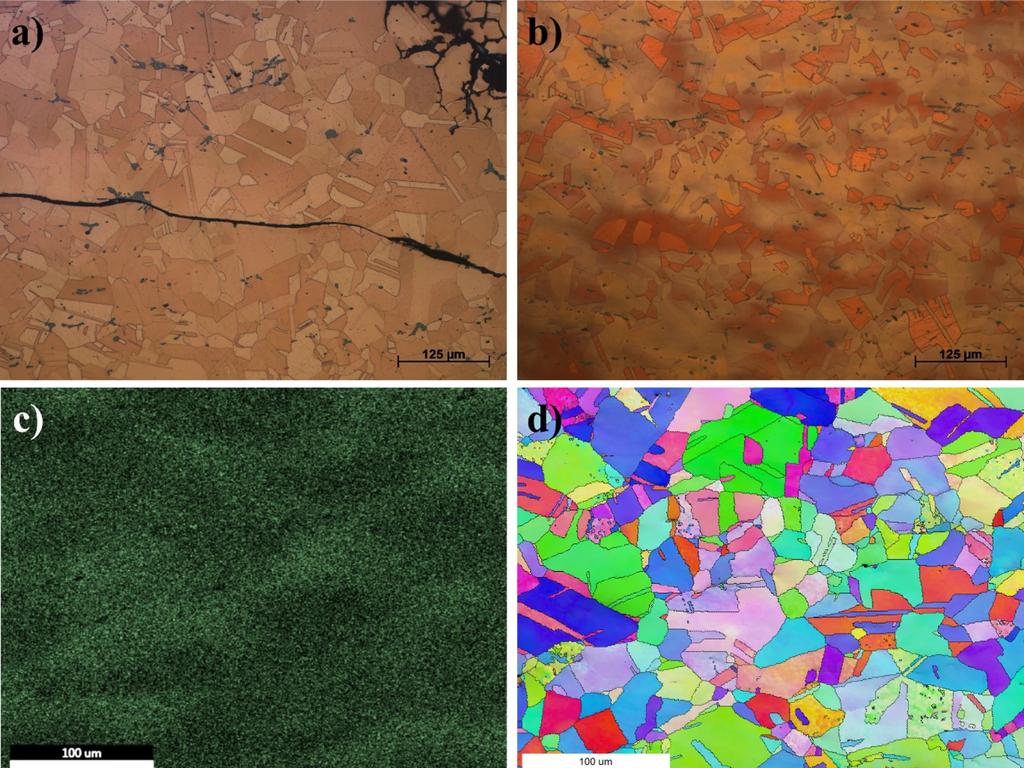
The looters were traced. And, as part of a bargain to reduce their sentences, the detectorists led police to a neolithic bank-and-ditch enclosure in Ziegelroda Forest where they insisted they had found the hoard.
Archaeologists recovered some evidence to support their claim. And the entire collection was eventually reassembled at the State Museum of Prehistory in Halle, Saxony-Anhalt, Germany.
Radiocarbon dating of timber in the hilts of the swords dates their burial to between 1600 and 1560BC. But corrosion found on the Sky Disk itself suggests it was already several hundred years old when interred.
Doubts persisted.
The disc was extraordinary. And its origins were uncertain. Given a flood of modified and forged artefacts on the market about the same time, evidence had to be found to confirm it really was what it appeared to be.
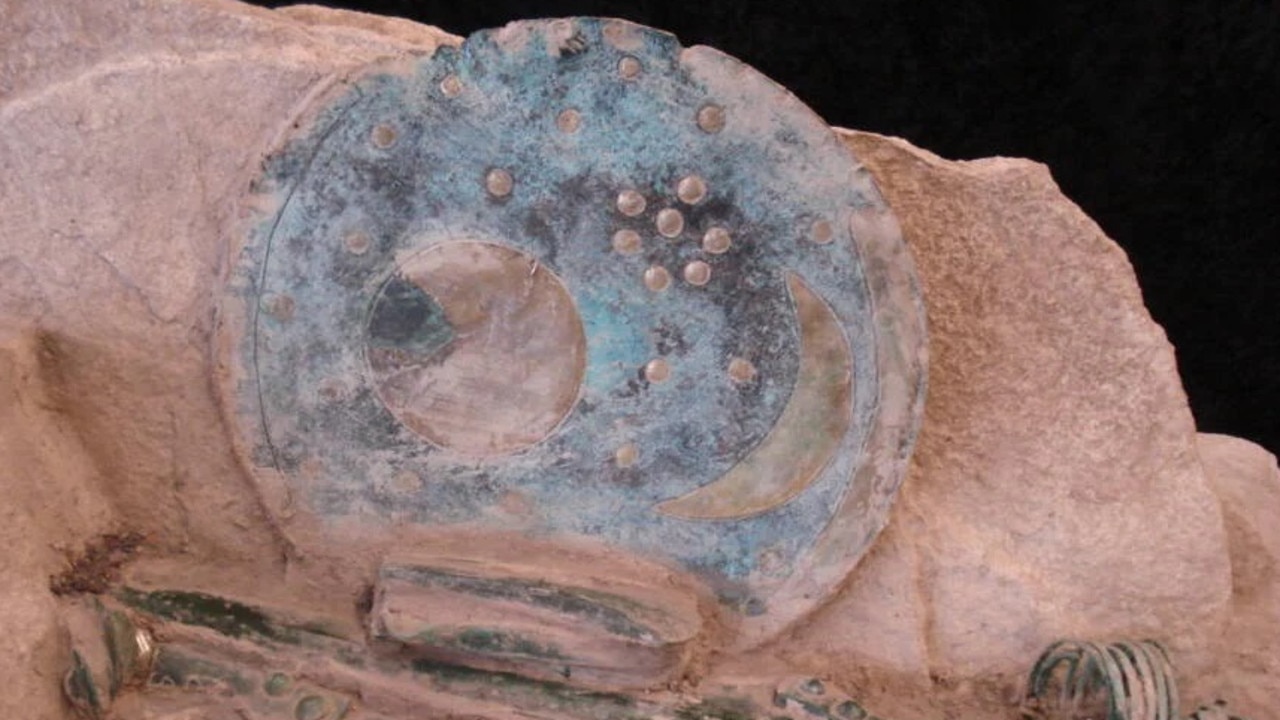
Forensic deconstruction
Modern machines and chemical processes leave distinctive fingerprints. But so, too, do ancient craftsmen and women.
So delving into the bronze disc’s chemical and structural makeup was always going to reveal the nature of its origins.
The famous Aztec Crystal Skull was sold to a startled public as evidence of the near-magical quality of the ancient Mexican culture. But a microscopic look at its transparent surface reveals it was cut with 18th-centuary rotary crafting tools.
Was the impossibly thin but strong bronze disc a similar modern scam?
A metal flake was removed from the Sky Disc in 2002 for metallurgical research. It revealed the copper used in the bronze was from a specific bronze-age mine in the Austrian Alps. Additional studies traced the oldest gold inlays to ore from Cornwall, England.
But this wasn’t enough evidence.
Recently, the bronze flake was re-removed and re-examined.
The most modern forensic imaging technology was applied.
Microstructural analysis traced the patterns of its colourised surface. X-ray spectroscopy and electron backscatter beams peered beneath its surface to “fingerprint” its crystalline structure.
The advanced technology revealed the Sky Disc was no simple bronze plate.
“The fact that the investigations have produced such fundamental new findings more than 20 years after the Sky Disc was secured not only demonstrates the extraordinary character of this find of the century but also how highly developed the art of metalworking was in the Early Bronze Age,” archaeologist Dr Harald Meller says in a statement.
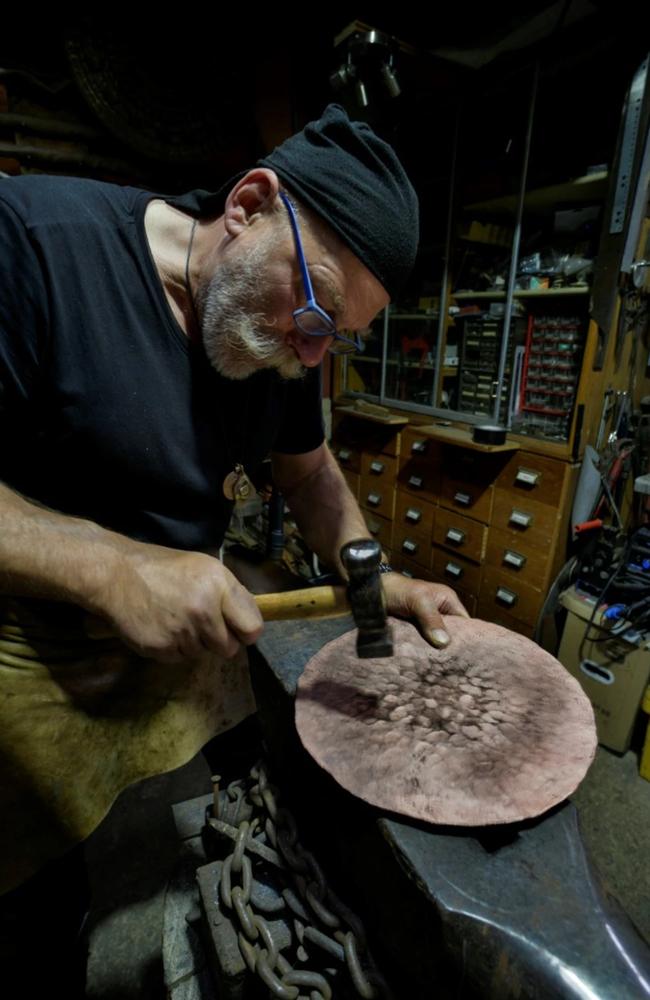
Time detectives
Once the Sky Disc’s microscopic metallic makeup had been mapped, German archaeologists set out to identify how this could be produced.
It didn’t match any known modern manufacturing process.
But evidence suggesting an ancient origin was also thin.
“The manufacturing of this disc differs from the making of other artefacts from the Early Bronze Age, eg the bronze axes,” the study states.
So the researchers hired a coppersmith to experiment with techniques believed to have been used by Germanic tribes to see if the outcomes matched.
Herbert Bauer took several flat casts of copper and tin, heated them to 700C, beat them into a circular shape and allowed them to anneal (cool slowly). He then repeated the process up to 55 times.
This labour-intensive process changed the crystalline structure of the bronze. It removed stress lines between the copper and tin. This made the thin plate much less brittle and more enduring than bronze found in ancient weapons and tools.
“To be fit for purpose, axes must have a high hardness in the cutting edge,” the study states. “Ornaments or ritual objects had to be durable and visually appealing.”
Eventually, the researchers determined the Nebra Sky Disc had been heated, beaten and cooled 10 times – the optimum level for creating a long-lasting alloy. Any more – or less – and the structure began to weaken.
The softer gold inlay was hammered into the bronze disc during the final phase. And it was only much later in its life that regularly spaced holes were punched into its edge so it could be sewn into fabric.
Evidence the Sky Disc is authentic is now substantial.
The researchers conclude the labour-intensive method of its construction is not one likely to be employed by modern forgers.
“The Nebra Sky Disc documents that the Únětice culture craftsmen were excellent and innovative copper smiths with extensive experience in sophisticated bronze manufacturing, including casting, forging and heat treatment,” the study concludes.
And the mine that produced its copper was only in use up to 3800 years ago.
“It cannot be very much younger because the composition of the alloy is very typical for bronze mined in the Austrian Alps,” Wunderlich adds.
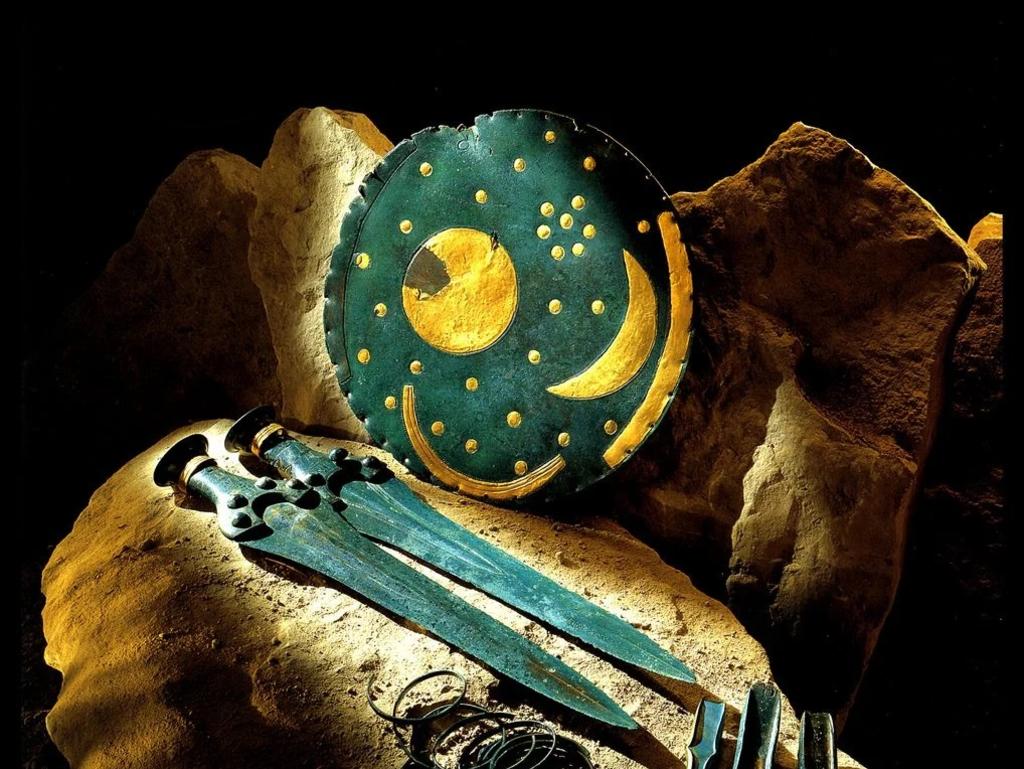
Mystery of the disc
Careful analysis of the Sky Disc over the past two decades indicates it was likely altered three times over the two centuries of its active life.
“In the earliest version, an elaborately encoded image reflects sophisticated astronomical knowledge,” the authors write in the Nature study.
“In subsequent stages, this was forgotten and replaced by traditional knowledge, which was focused on the interaction of the heavenly bodies and the horizon. Finally, this reduced knowledge gave way to mythology.”
It now seems certain the original bronze disc was forged about 1800BC.
It was a time when agriculture was becoming entrenched in Europe. Ancient neolithic hunter-gatherer cultures had all but vanished. And the disc was made as one civilisation known as the Beaker People (because of the distinctive pottery they made) gave way to another.
A new social structure based on wealthy warrior elites was becoming entrenched.
The Sky Disc’s golden orb (probably the sun, but also maybe a full moon), crescent moon and 32 small round gold circles – likely representing stars – have been identified as its original adornments. One distinctive grouping is thought to represent the Pleiades star cluster.
Farmers knew it was time to sow their crops when this star cluster vanished over the horizon every spring.
Later, two bracket-like 82-degree arcs were added to the disc’s sides. One arc has lost most of its gold inlay. The other remains largely intact. But the gold here is different from that found in the original inlays. Significantly, the span of these arcs matches the angle between the position of sunsets at the summer and winter solstices at 51 degrees north – the same latitude as Mitelberg Hill, where the disc was found.
Anyone holding the Sky Disc in alignment with landmarks defining each equinox (such as a stone or timber circle) would, at sunset, be able to pinpoint the exact time of year.
Later still was the addition of a golden arc at the bottom of the Sky Disc. Its squared-off ends suggest this shape is not celestial. Instead, archaeologists believe it may be a stylistic representation of a solar boat – a mythical means by which the sun moved from west to east every night. Another suggestion is the shape represents essential tools of the harvest, such as a scythe or sickle.
Jamie Seidel is a freelance writer | @jamieseidel.bsky.social
Originally published as ‘Extraordinary’: Mystery of the ancient Nebra Sky Disc explored





